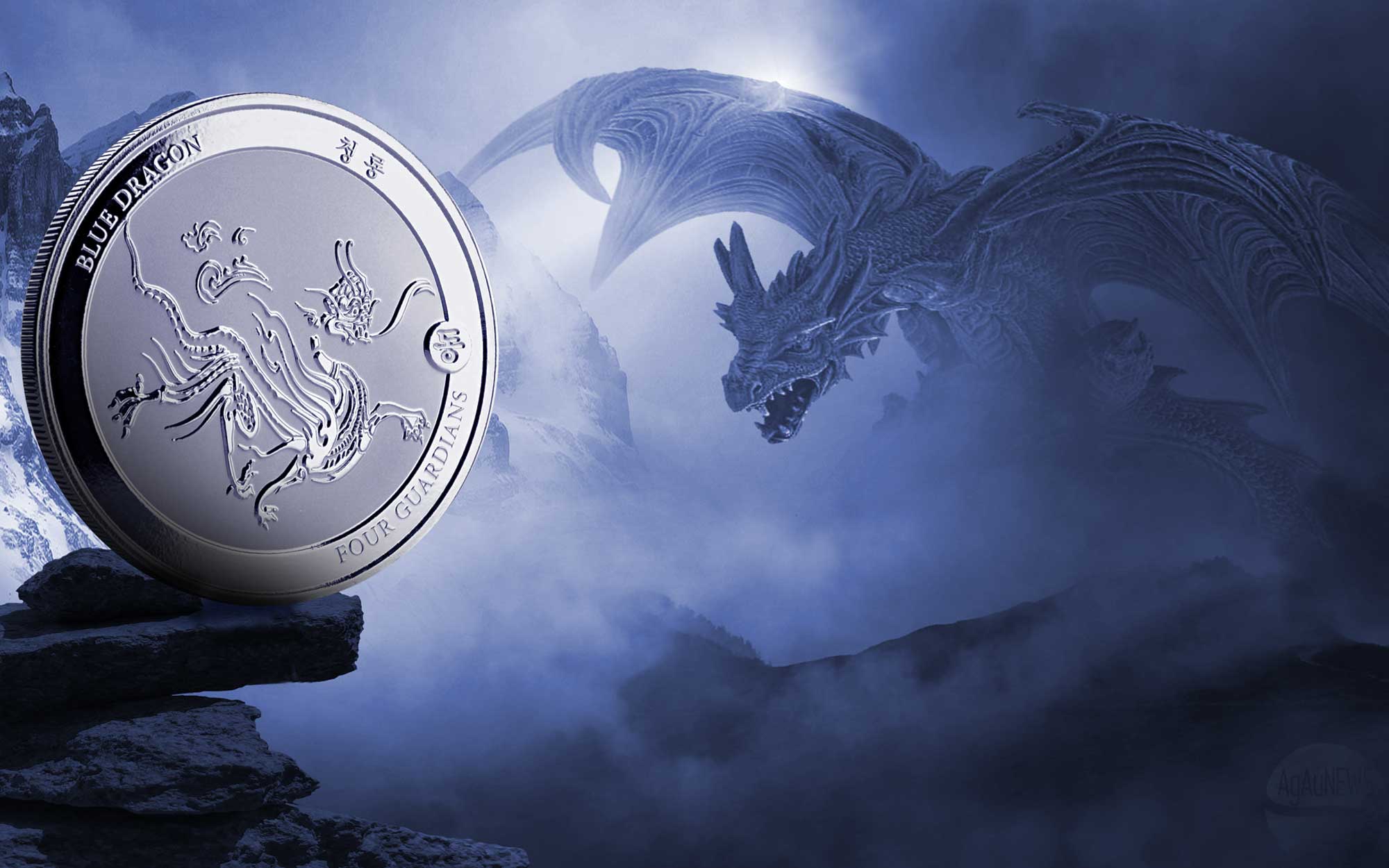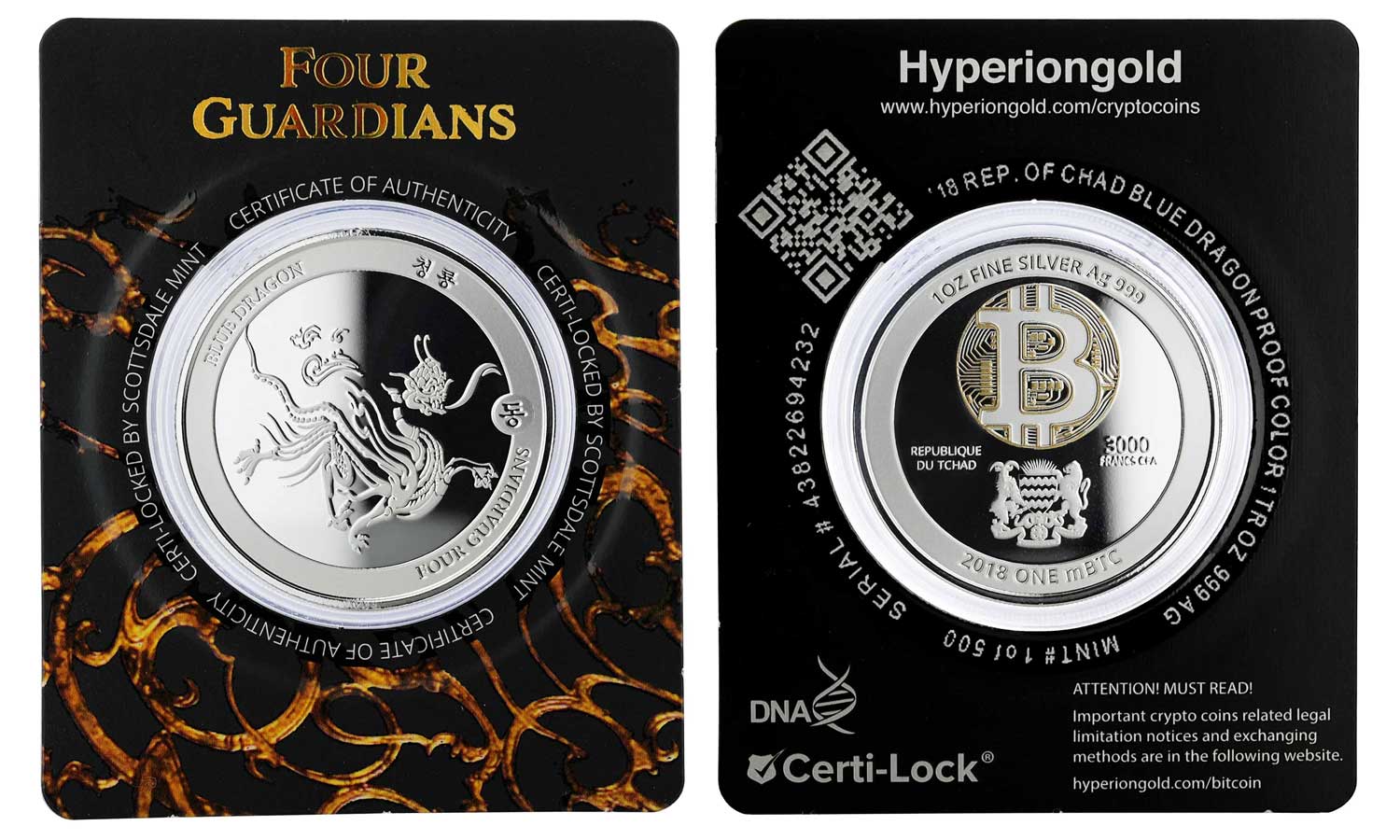Scottsdale at it again, with a striking series of East Asian mythology bullion coins called Four Guardians
It’s been a manic year at Scottsdale Mint given what has been a wide and varied program of bullion coin releases. The Fiji Mermaid, Cayman Islands Marlin, Congo Silverback, Samoan Seahorse, the Chinese Dragon for Cameroon, and the Ghanaian Leopard have all brought some cool design to the limited run bullion coin market – and that’s not even counting the new Royal Arms of England, and Caribbean EC8 programmes. Add in a move to China from Egypt for the chunky range, and you can’t help but be impressed by the choice on offer.
Despite the year heading to a close, there’s more to come with the debut of a new Asian-inspired series called Four Guardians. Distributed by Korea-based dealer Hyperion Gold, this is a small mintage series with a striking visual style. The first is Blue Dragon, also called the Azure Dragon of the East and will be followed by a bird, a tiger and a turtle. The sparse look works well, and the choice of a smaller font than usual for the inscriptions in the border, adds to the appeal.
Issued for the Republic of Chad in Africa, the obverse carries that nations coat of arms at the bottom, along with a larger Bitcoin logo above that. Despite that, this is denominated in Francs CFA, a currency used by several nations in the region. Three versions are available, all with the same design. Bullion coins are one-ounce in weight and offered in either 9999 gold or 999 silver. Mintages are super tight at just 100 for the former and 15,000 for the latter. In addition, there’s a proof silver coin with some subtle colour on the obverse face. Only 500 of these will be produced.
Whatever version you buy, it comes in Certi-Lock packaging. Like a wide credit card, the coin is sealed in its tamper-proof centre. The back of the card has a serial number, mintage number and an encrypted barcode. This can be read using only special smartphone app, so on the whole, far more secure than the typical bullion coin, especially with a synthetic DNA embedded within it as well. We’ve yet to get full details of the coins, but they are already up for sale at Hyperion Gold. We’ll update this article as we get more information.




FOUR GUARDIANS
The Four Symbols, or Four Guardians, are a quartet of mythological creatures in the East Asian constellations. They are the Azure Dragon of the East, the Vermilion Bird of the South, the White Tiger of the West, and the Black Turtle of the North. Each one of them represents a direction and a season, and each has its own individual characteristics and origins. Symbolically and as part of spiritual and religious belief, they have been culturally important across China and East Asia, particularly Korea.
In 1987, a tomb was found at Xishuipo in Puyang, Henan. There were some clam shells and bones forming the images of the Azure Dragon, the White Tiger, and the Big Dipper. It is believed that the tomb belongs to the Neolithic Age, dating to about 6,000 years ago. The Rongcheng Shi manuscript recovered in 1994 gives five directions rather than four and places the animals quite differently: Yu the Great gave banners to his people marking the north with a bird, the south with a snake, the east with the sun, the west with the moon, and the center with a bear.
The colours of the animals also match the colours of soil in the corresponding areas of China: the bluish-grey water-logged soils of the east, the reddish iron-rich soils of the south, the whitish saline soils of the western deserts, the black organic-rich soils of the north and the yellow soils from the central loess plateau.
These mythological creatures have also been synthesized into the five principles system. The Azure Dragon of the East represents Wood, the Vermilion Bird of the South represents Fire, the White Tiger of the West represents Metal, and the Black Turtle (or Dark Warrior) of the North represents Water. In this system, the fifth principle Earth is represented by the Yellow Dragon of the Center.
The four beasts each represent a season. The Azure Dragon of the East represents Spring, the Vermilion Bird of the South represents Summer, the White Tiger of the West represents Autumn, and the Black Turtle of the North represents Winter. (Source: Wikipedia)
COMPLEX OF KOGURYO TOMBS
Koguryo was one of the strongest kingdoms in northeast China and half of the Korean peninsula between the 3rd century BC and the 7th century AD. The best known cultural heritage remains of this kingdom are the tombs, built of stone and covered by stone or earthen mounds. These tombs, from the middle period of the kingdom, many with beautiful wall paintings, are the representative remains of this culture. About 100 out of more than 10,000 Koguryo tombs discovered in Democratic People’s Republic of Korea and China to date are decorated with wall paintings, some 80 of which are in the Democratic People’s Republic of Korea. Among the Koguryo tombs identified in Democratic People’s Republic of Korea, 63 individual tombs including 16 tombs with wall paintings are included in the inscribed property.
The Complex of Koguryo Tombs is a serial property and includes several groups and individual tombs situated mainly at the foot of mountains and some in villages. Located in Pyongyang and surrounding provinces, the tombs are thought to have been made for the burial of kings, members of the royal family and the aristocracy.
There are several types of tombs included in the property, based on the number of burial chambers – single chamber, two chambers, and multi-chambers with side chambers. They represent the full range of the Koguryo tomb typology and showcase the best examples of this construction technology. The tombs are monumental, stone-chambered earthen mounds that were skillfully constructed with ingenious ceiling designs to support the heavy weight above. The technology employed represented a unique, creative and long-sought engineering solution to the technical problems posed by underground tomb construction.
The wall paintings constitute masterpieces of the art of wall painting. The subject matter of the wall paintings of the tombs offers unique evidence of the richness and complexity of the now-vanished Koguryo culture, portraying the costumes, food, residential life and burial customs, as well as religious practices and imagery associated with Buddhism, Taoism and the Four Deities.
The Complex of Koguryo Tombs represents an exceptional testimony to the Koguryo culture, its burial customs, daily life and beliefs. The special burial customs of this culture had an important influence on other cultures in the region, including those of Japan. (Source: UNESCO)
| SPECIFICATION | |||
| DENOMINATION | 3,000 Francs (Chad) | 500 Francs (Chad) | 3,000 Francs (Chad) |
| COMPOSITION | 0.9999 gold | 0.999 silver | 0.999 silver |
| WEIGHT | 31.1 grams | 31.1 grams | 31.1 grams |
| DIMENSIONS | 32 mm | 40 mm | 40 mm |
| FINISH | Bullion | Bullion | Proof |
| MODIFICATIONS | None | None | None |
| MINTAGE | 100 | 15,000 | 500 |
| BOX / COA | Certi-lock | Certi-lock | Certi-lock |







Thanks for another great Scottsdale article. Love this design & series idea. Another great Scottsdale issue. But hmm, not fond of the big bitcoin logo. That’s just me.
But, crypto being huge in S Korea, i guess they think it will lend appeal there with the denomination of one millibitcoin, as well. Could overlook the btc gimmick for the appeal of the blue dragon design.
What i couldn’t overlook is the Hyperion shop is pricing the 15,000 mintage silver bullion at US$50 though, which if this is the going rate upon distribution, will kill the bullion stone cold.
At more normal Scottsdale bullion prices (plus the BTC margin, and a margin for the certi-lock as per the Fiji Iguanas) i would have been in for one at US$30 tops.
Be interesting to see asking prices once they get spread out to dealers.
Not a fan of the Bitcoin logo either. I’m still waiting for more official info, as the Korean site is full of great backstory, but light on coin details. I didn’t check the price, to be honest. I like to keep things price-agnostic here and leave it up to the buyer to determine if its good value or not (the info in an article can also date rapidly), but that does seem quite high for a launch price.
I love the design though. Really appealing to me. Can’t wait to see the others.
I am Korean and looked at Hyperion’s website and talked to them. The coin comes with physical Bitcoin on it that you can redeem! So you get anywhere from 1 to 20 mBTC (millibit) so that equates to about 5 to 100 USD extra that is built into the premium. https://www.hyperiongold.com/untitled-19 I guess when you buy it you get a special secret code to redeem Bitcoin into wallet of choice such as Bithumb, Monarch Wallet, Ethos, etc.
Each guardian will represent a different “Crypto” coin and the first is Bitcoin. I don’t know what the other coins will be yet. Maybe an idea for AgAuNews to do a follow up article on this interesting crypto connection.
I’m amazed that there’s a great product out there. In addition, I wonder how I can get Bitcoin. Do you have an Crypto Wallet from the publisher?